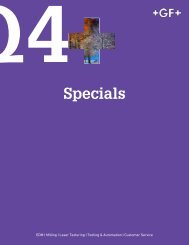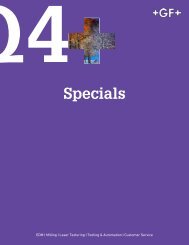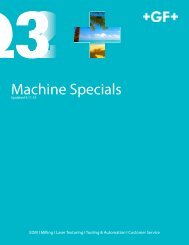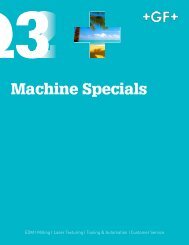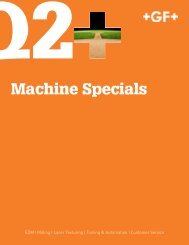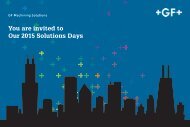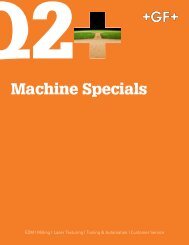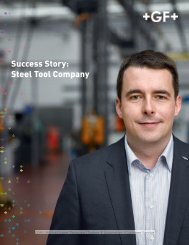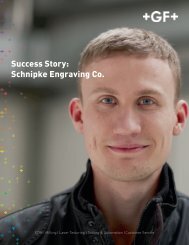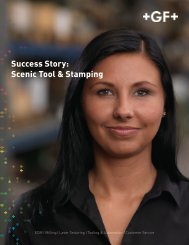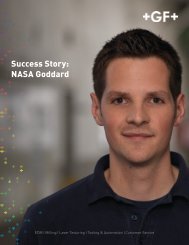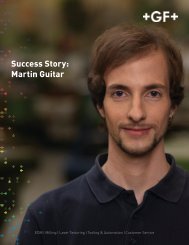Custom Etch Inc.
You also want an ePaper? Increase the reach of your titles
YUMPU automatically turns print PDFs into web optimized ePapers that Google loves.
Success Story:<br />
<strong>Custom</strong> <strong>Etch</strong> <strong>Inc</strong>.<br />
EDM I Milling I Laser Texturing I Tooling & Automation I <strong>Custom</strong>er Service
Large Laser Changes the Texture of Automotive Molding<br />
<strong>Custom</strong> <strong>Etch</strong> <strong>Inc</strong>, a 35-person shop in New Castle, Pennsylvania,<br />
has specialized in chemical etching since 1982.<br />
However, in 2011, the shop made a bold move to significantly<br />
expand its capabilities beyond chemical etching and invested<br />
in advanced 5-axis laser-texturing systems.<br />
Fast-forward to the present, and <strong>Custom</strong> <strong>Etch</strong> now currently<br />
holds the distinction of being the first U.S. shop to own<br />
one of the industry’s largest laser texturing systems. With<br />
a working envelope big enough to park a full-size car, this<br />
recently added system has driven a significant increase in<br />
the company’s automotive business.<br />
After only a month of testing and training on the large<br />
machine, the shop began using it for production work. The<br />
new system is expected to increase revenue 15 percent in<br />
2014 and Don Melonio Jr., vice president of <strong>Custom</strong> <strong>Etch</strong>,<br />
expects that number to increase to 25 percent in the following<br />
year. He explained that the need for such a massive<br />
machine grew out of the desire of automakers to texture interior<br />
components that were previously grained using laser<br />
textured foils. These foils were then wrapped onto master<br />
models used to create tooling. This is an expensive and<br />
time-consuming process and not without its flaws.<br />
“What the laser allows automakers to do is choose textures<br />
that prior to this technology were impossible with traditional<br />
machined tooling,” said Melonio. “So now with laser texturing,<br />
they can add aesthetics where it was previously impossible.<br />
And, because you’re taking the labor component out<br />
of the texturing, you’re also reducing time to market. Laser<br />
texturing of large components can result in significant time<br />
savings versus chemical etching, while cost remains virtually<br />
the same.”<br />
Installed in a new, temperature-controlled building, <strong>Custom</strong><br />
<strong>Etch</strong>’s LASER 4000 5Ax laser texturing system from GF<br />
Machining Solutions features a capacity of over 13 feet by<br />
nine feet by four feet. And since workpieces sit on the floor<br />
for processing, the machine’s weight capacity is limited only<br />
by <strong>Custom</strong> <strong>Etch</strong>’s overhead crane capacity. For automotive<br />
customers, that means oversize molds for components<br />
such as bumpers and fascias, instrument and door panels,<br />
central consoles, airbag covers and much more – including<br />
whole interiors – can be laser textured.<br />
The huge system joins the shop’s initial LASER 1000 5Ax<br />
and LASER 1200 5Ax machines, also from GF Machining<br />
Solutions. And all three machines complement the shop’s<br />
chemical etching processes. The smaller lasers handle<br />
parts to 11.8 inches on a side and 27.5 inches on a side. And<br />
a GF Machining Solutions-supplied System 3R pallet system<br />
further enhances their productivity with lights-out operating<br />
capability.<br />
Like the smaller systems, the LASER 4000 5Ax features a<br />
standard programmable tilting laser head, high-resolution<br />
cameras with integrated illumination for fine positioning,<br />
integrated touch probes and dust exhausts, a central lubrication<br />
system and various lenses.<br />
The texturing process begins with a digital bitmap/grayscale<br />
file created in Photoshop or derived from a natural surface<br />
by reverse engineering via a 3D scanner. System software<br />
then merges a virtual workpiece with a virtual texture, and<br />
shops can then preview the final design. With the pattern<br />
loaded, the laser removes material in, for instance 10 to 150<br />
layers, to impart the texture pattern.<br />
The <strong>Custom</strong> <strong>Etch</strong> building that houses the large system has<br />
a 25-ton crane and machine foundations three-feet thick.<br />
The concrete floor has internal heating to control the temperature<br />
of mold tooling, regardless of the outside temperature.<br />
Two 20-ton air conditioning units keep the building at a<br />
constant 69 degrees all year around.<br />
“Once the LASER 4000 5Ax was here, we started to make<br />
contact with automotive companies,” recalled Melonio. “The<br />
initial response was, ‘Great, but what does it cost versus<br />
traditional etching?’ And we were able to answer, ‘It doesn’t<br />
cost any more than chemical texturing, and here are all the<br />
benefits versus chemical texturing.’”
Those benefits include eliminating the need to disassemble<br />
and then reassemble complex plastic injection molds – a<br />
requirement for chemical etching that creates a significant<br />
cost, according to Melonio.<br />
To chemically etch a mold, workers must disassemble it<br />
down to the base components – the cavity block and core<br />
block, all the inserts, fittings, hoses and wires. Unfortunately,<br />
all those components are then very susceptible to<br />
getting acid and sand on them, which can cause operational<br />
problems and damage.<br />
After chemical etching, reassembly of the mold can take<br />
days. Laser texturing, on the other hand, eliminates the<br />
need to disassemble the mold and allows easier and more<br />
accurate repair of cavities or cores in tools that have been<br />
damaged or worn during production. The process also<br />
works across various mold materials, enabling the use of<br />
multiple materials and potentially having a huge impact on<br />
molding productivity and profitability.<br />
“A laser can create textures across varying materials and<br />
have all of the textures match perfectly,” explained Melonio.<br />
“Traditionally, automotive manufacturers avoided mixing<br />
tool materials because they would cause variations in the<br />
texture. Now they have the opportunity to have a set of P20<br />
steel tools mixed with a set of, for example, aluminum tools.<br />
Aluminum cools at a much faster rate than P20 does, so<br />
molds can have much faster cycle times. If manufacturers<br />
can produce more parts in the same amount of time,<br />
the price per part drops. If that happens across an entire<br />
platform – a vehicle with many plastic parts for instance –<br />
and you’re producing 300,000 vehicles, the savings add up<br />
quickly.”<br />
Additionally, the ability to mix tool materials without creating<br />
witness marks and other telltale signs of mismatch on<br />
the product is especially important for automotive interior<br />
components. In these applications, color, gloss, fit and finish<br />
of multiple parts must all match precisely.<br />
The LASER 4000 5Ax applies to more than just large parts at<br />
<strong>Custom</strong> <strong>Etch</strong>. One example is smaller tooling for molds that<br />
generate headlights and other lenses. Automotive engineers<br />
continue to design such components with increasingly<br />
complex details to refract more light and improve safety.<br />
And according to Melonio, the laser can create these precise<br />
features such as diamonds, squares and lines in molds for<br />
headlights and lenses without dulling the other surfaces of<br />
the mold tool.<br />
“Laser technology produces lots of little details while<br />
maintaining a high polish on the areas between the features<br />
of the lens tooling,” said Melonio. “That’s not possible<br />
using chemical etching because those areas would have to<br />
be sandblasted to clean them after the process. So, laser<br />
texturing is a big deal for the lens manufacturers. It offers<br />
them another option besides electrical discharge machining<br />
(EDMing) when it comes to creating a lot of features in<br />
lens molds while maintaining a high polish between those<br />
features.”<br />
Yet another key attribute of laser texturing for automotive<br />
customers is the ability to reproduce textures while globally<br />
sourcing parts. The technology’s accuracy and repeatability<br />
means that, once a texture pattern is developed for laser<br />
processing, tools for the component can be sourced in the<br />
location that is most convenient for production.<br />
A company that is sourcing tools to Asia, Europe and the<br />
United States, for example, can send the same texture pattern<br />
information to all its suppliers. The texture of all the<br />
tooling will match no matter where it’s produced, commented<br />
Melonio.<br />
“One of the biggest issues with conventional texturing,” he<br />
said, “is that automotive engineers believe all the tools –<br />
such as for the interior components – for a single model<br />
car, need to go to a one supplier. The concern is that tools<br />
textured by different suppliers will vary and lack consistency.”<br />
As a result, shops that perform texturing have what are<br />
known as “harmony rooms” for checking gloss, texture,<br />
and other attributes of finished components,” said Melonio.<br />
Tools may be sourced in one country then shipped halfway<br />
around the world to be textured.<br />
“But if you generate that pattern on a laser machine anywhere<br />
in the world, it will be spot on in terms of texture,<br />
gloss and other characteristics. And as a manufacturer you<br />
can then source tools anywhere in the world and be confident<br />
they will match perfectly,” he said.<br />
Melonio believes <strong>Custom</strong> <strong>Etch</strong> caught the leading edge of<br />
an automotive laser-texturing wave that is just starting to<br />
go global. In fact, the company is prepared to add as many<br />
large laser-texturing systems as its climate-controlled facility<br />
will hold. But he also knows that competitors across the<br />
globe are adding the capability as well.<br />
And while much of the work on the large laser-texturing<br />
system is automotive-related, <strong>Custom</strong> <strong>Etch</strong>’s philosophy<br />
is to maintain a diverse customer base, which means the<br />
machine also processes components for a number of other<br />
applications. These include large molds for recreational vehicles,<br />
building trades, aerospace and medical components.<br />
“Our philosophy has always been diversification. We will<br />
continue to service all markets and remain committed to<br />
growth in all fields. We see a tremendous potential in automotive<br />
and have made large investments in laser technology<br />
and will continue to do so going forward,” said Melonio.
GF Machining Solutions<br />
GF Machining Solutions<br />
560 Bond Street<br />
Lincolnshire, IL, 60069<br />
USA<br />
Website: www.gfms.com/us<br />
Email: info.gfms.us@georgfischer.com<br />
Phone: 847-913-5300<br />
© Machining Solutions, 2015<br />
The technical data and illustrations are not binding.<br />
They are not warranted characteristics and are<br />
subject to change.<br />
Facebook: facebook.com/gfmachiningsolutions<br />
Twitter: twitter.com/gfms_us<br />
YouTube: youtube.com/agiecharmilles<br />
Version 1.1



